by Lars Hasvoll Bakke, CreStock
From the seven years between 1969-76, we are left with a vast heritage of marvelous propaganda material. In the second part of this series, we take a look at more carefully selected posters from that period.
In part 1, we finished off with a poster ordering the red guards of the cultural revolution to disperse into the countryside, or in other words, breaking them up to avoid turning the cultural revolution into a civil war. Mao was central in launching that revolution, and would be central in ending it, backed by the People’s Liberation Army, which was fed up with teenagers looting their armories.
With the demise of the red guards, the cultural revolution proper came to an end. While Mao remained in power, there were still people trying to climb the party ladders, either to gain supreme power themselves, or to get in line ahead of Mao’s eventual death. The power struggles in the Communist party thus carried on until a bit after Mao’s death in 1976.

1969 – The Chinese People’s Liberation Army is the great school of Mao Zedong thought
This power struggle would be echoed in many of the propaganda posters of the time. You’ll see a few examples of the propaganda warfare that went on between different people and factions, and believe me when I say that this is only a fraction of the available material dealing with this or that party member being a capitalist, a bastard or a counter-revolutionary.
Though the Cultural Revolution was a solid disaster, Mao kept going and remained the most elevated and venerated poster boy of Chinese propaganda. Mao’s somewhat idealized likeness, coupled with the Little Red book, were potent symbols backing his prestige, and were spewn across China with particular intensity after 1968. The relatively modest amount of Mao posters in this post does not fully reflect this, quite simply because I expect you might get bored after resting your eye on his kind, fatherly face for the umpteenth time.
I remember this particular poster as one of the fist Chinese propaganda posters I ever really noticed, the first that stuck in my mind. Everyone are so focused, so clearly geared towards one common goal, presumably as laid out in the Little Red. Naturally, I could not resist importing this image into MS Paint, painting pirate hats, mustaches and goatees on everyone. Try it, it’s fun.

1969 – The invincible thought of Mao Zedong illuminates the stage of revolutionary art!
You might remember Madame Mao from part 1, or Jiang Qing which is her actual name. Well, she’s back. Some say she never left. And they’re right at that. Anyway, seeing as she was originally an actress, supposedly of average skill, directing the more distinctly cultural issues was something she took easily to. Like everything else at the time, matters of music, stage performance and so on were all best instructed using the universal handbook and remedy, the Little Red, which Jiang is seen holding.
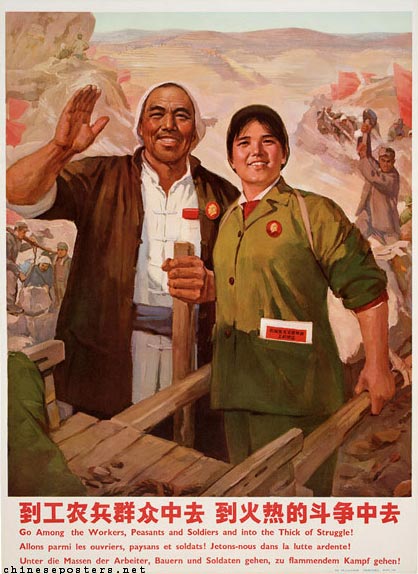
1970 – Go among the workers, peasants and soldiers and into the thick of the struggle!
An export poster, printed in Mandarin, English, French and German. Among the rebellious students of western Europe of the 60’s and 70’s, Maoism became a popular ideology. Stalin, and to some degree his successors, had made Soviet style communism unattractive, while Maoism appeared fresh and untainted. As we’ve seen with the Great Leap Forward and the Cultural Revolution, that was far from the case, but a combination of genuine and faked ignorance allowed many to study the words of Mao’s Little Red without worrying too much about its dark sides.

This pouncing fellow is Huang Jiguang, a celebrated hero of the Korean War. Having expended all his ordnance during an attack on an American machine gun pit, Huang flung himself unarmed at the position. The attack succeeded, but Huang was killed. A popular role model seen in posters up until recent years, he’s typically seen in a similarly dramatic posture leaping fearlessly into the fire.
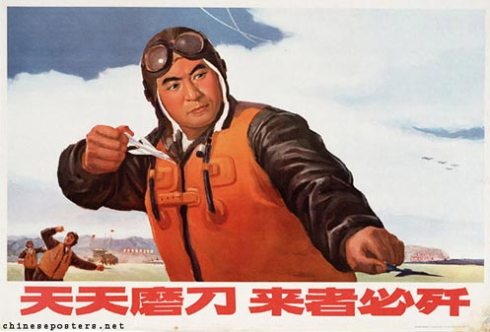
1970 – Sharpening the knife day after day, intruders must be annihilated
… or as I would have preferred the message, “Resolutely play with toy planes every day to defend the socialist Motherland and Mao Zedong Thought”.You can hardly help laughing, or at least giggling a little at the sight of a grown man in full flight gear playing so determinedly with toy planes. I suppose it’s one way of saving jet fuel, but honestly, is it really suitable in propaganda material meant to encourage the pilots?

1970 – Struggle to increase the mechanization of agriculture
What a smile! There’s something wonderful about this girl’s exuberant, dazzling smile being provoked by the thought of increased agricultural mechanization. The viewer is left to guess whether it’s the quality of the wrench, the pleasures of driving a tractor or the general thought of mechanization which is the key factor.

1970 – What is there to fear when one’s heart is filled with the morning sun? They dared to devote their youth to the people. Let’s learn from the spirit of the 11 educated youths of Shanghai’s Mount Huangshan Tea and Forest Farm: “Fear neither hardship nor death.”
In 1969, half a million Chinese supposedly subdued a tidal wave using Mao’s Little Red. With the girl in focus here holding that book in her hand, I’m guessing this is a propaganda depiction of that event. If one is to believe the claims made about the book in this period, it would seem we are dealing with nothing less than the most powerful book in the world. The mere presence of the book, or reading a few passages could solve any problem.

1970 – Down with the leading capitalist roaders now in power within the party
As mentioned in the first part of this series, simple and dramatic posters in red, black and white with a rustic look were a trademark of the Cultural Revolution. The people directing the revolution were also to a large extent the ones behind the continued use of this style after the revolution proper had ended; Mao and his clique.
More moderate, pragmatic party officials like Deng Xiaoping and Liu Shaoqi would be the typical targets, and I wouldn’t be surprised if they are the purported capitalists this poster speaks about. The fact that Shaoqi had died in captivity the previous year would not make a difference since his death was kept an official secret for many years.
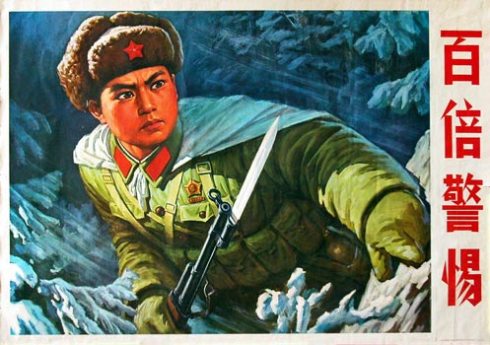
1971 – One hundred times vigilant
It’s interesting to note that a large portion of Chinese posters showing PLA soldiers on post, show them in a snowy environment. It could just be a coincidence, but more likely, it reflects the People’s Republic’s foreign relations situation at the time – the prime enemy not being capitalist USA to the east but the fellow communists of the Soviet Union to the north.
A low intensity border war existed between the two giants at the time, something US president Richard Nixon and his famous National Security Advisor, Henry Kissinger, were eager to exploit. Seeing an opportunity to gain a new ally against the US’ prime enemy, the Soviet Union, Kissinger travelled under the utmost secrecy to Beijing in 1971 to discuss their common interests.

1971 – Hold aloft the red lantern
One aesthetic aspect of propaganda posters which I find interesting is the postures and expressions typically seen in the people. They’ll quite often fall into one of two categories, exuberantly happy or disturbingly determined. The happy people will often be happy about something seemingly trivial, like the girl with the tractor and wrench earlier in this post, while the determined folks will look like caricatures.
This is a good case study in that regard. While this girl does not sport the kind of facial expression that makes her appear ready to explode due to over-determination, her posture is a bit ridiculous. Look at her right arm and fist. Nobody does that in reality unless they’re trying to be funny, which leads us to something which should be obvious when it comes to propaganda; it’s not real.

1971 – Imperialism and all reactionary forces are paper tigers
I love the paper tiger phrase. Being a European, I often have problems understanding Chinese symbols, sayings and manners, but this one seems within my grasp. While the concept is ancient, Mao interpreted the US, and later the Soviet Union to be the great paper tigers. They appeared big and threatening, but were really of little substance and would crumble like paper if pushed.
This scene is taken from the Korean war, you may notice that the helmet of the soldier in the tank carries US insignia. In that regard, the Korean war is sort of a bad example of the US being a paper tiger, seeing as the war ended in a status quo, without the US crumbling in any obvious way.
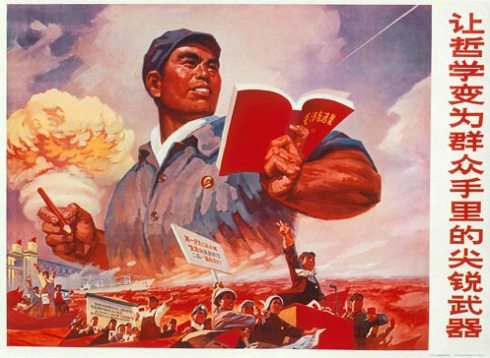
1971 – Let philosophy be transformed into a sharp weapon in the hands of the masses
I don’t recall ever seeing a nuclear mushroom portrayed in such a positive way. From the composition of this poster, it seems like everything else practically grows out of the nuke, as if that’s THE driving force behind the Chinese revolution.
Again, it’s really all about the great power of the Little Red, in this case carried forth by a giant of a man, equipped with the most ridiculously proportioned underarm I’ve ever seen.

1971 – Proletarians all over the world unite!

1971 – Seas and oceans are not separated, the silver needle passes on friendship
From 1965 onwards, thousands of medically trained Chinese were ordered into the countryside to bring basic healthcare to the country’s huge rural population. Due to them often not wearing shoes, they eventually came to be called “barefoot doctors”. This poster apparently shows one such doctor administering vaccines somewhere in Africa. While in fact wearing shoes, there’s no doubt he’s in a rather rural area, thus in essence making him a barefoot doctor.

1972 – Study revolutionary plays to become a revolutionary
Again we see PLA soldiers stationed in a snow covered spruce forest. This time, they don’t seem as vigilant as earlier, caught up as they are becoming better defenders of the socialist motherland by watching this improvised play.
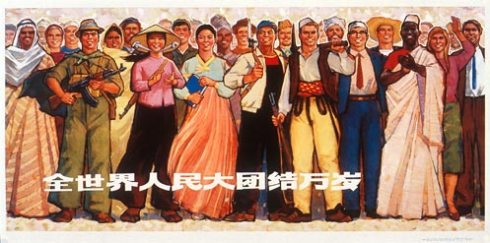
1973 – Long live the Unity of the People of the World
I know I’ve talked a lot about teeth so far, so I’ll make this the last time. There is something remarkable about the depiction of human teeth in some of these posters. Thin, symmetrical slots, impeccably white blocks of solid ice. I’m sure most of you have noticed. I have no idea what the background for this is, I’m sure it’s some old cultural thing, deeply ingrained in the soul of China. If any of you readers have a clue about this aspect of Chinese propaganda, do let me know!
Beyond the teeth, I really like this poster. It may just be because I was raised in a home were international solidarity was stressed as important, but this gathering of all sorts of happy people, well, it just makes me happy! I should also note that I find the graphic work here quite excellent, with a sort of ordered chaos coupled with a pleasant use of colours and contrasts.
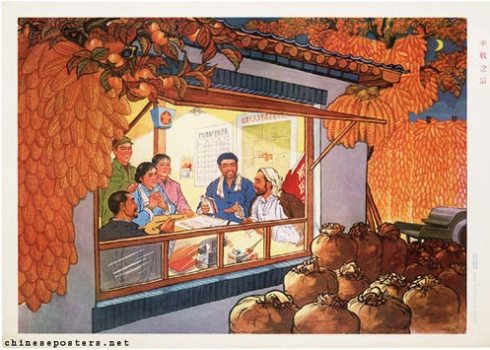
1974 – After the bumper harvest
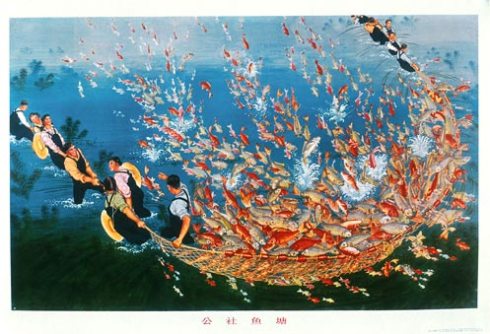
1974 – The commune’s fishpond
Two nice examples of works by the so-called Huxian peasant painters. According to the official story, these painters were more or less pulled randomly out of the population and used as examples of the artistic skills which lay dormant within all. They received much publicity and international acclaim for their work, and not unexpectedly, it was later revealed that they had in fact been helped along by professionals. They call it propaganda.
The Soviet Union had similar programs, where talented people from “primitive” minority people would be sent to special academies to develop their innate abilities, without them being “spoilt” by exposure to western civilizations’ artistic traditions. Konstantin Pankov was one of these. Of Nenets extraction, Pankov hailed from the far northern areas of Russia, where he had been a hunter on the frozen Taiga. In his short life, he had time to paint some amazing pictures, before being killed near Leningrad, where he fought as a sniper and scout during World War II.

1974 – Protect the grand achievements of the Great Proletarian Cultural Revolution
Around this time, the power struggle in the communist party got real intense. The battle lines appear somewhat diffuse. To simplify, we can say that on the one side, you had the Gang of four, consisting of Mao’s wife, Jiang Qiang, Mao’s new political darling Wang Hongwen as well as propaganda specialists Zhang Chunqiao and Yao Wenyuan. While the Gang of four were partial to continuing Mao’s cultural revolution program, their opponents were of a more pragmatic kind, spearheaded by Deng Xiaoping, who would rather get things back to normal and achieve reconstruction after many years of turmoil.
In between these outer points were the People’s Republic’s long time premier and master diplomat, Zhou Enlai, as well as Hua Goafeng, who advocated a return to Soviet style central planning. Keeping in mind what I just mentioned about the Gang of four, it seems likely that this poster originates from their circles of power. With effective control over party propaganda and two specialists in the field as part of the group, the Gang’s messages came to dominate the People’s Republic in the coming few years.
What attracted me to this particular poster was the fabulously feisty look of the young revolutionary in pink. Like all positive propaganda personalities, she puts intense pride into what she’s doing, in this case painting some revolutionary slogan on the wall. One less impressive quality in this poster is how the message at the bottom has been outlined in white. Earlier posters would typically have the message printed on the white area beneath the painting in itself, but here, it’s been outlined in white and printed inside the painting, and it looks like shit.
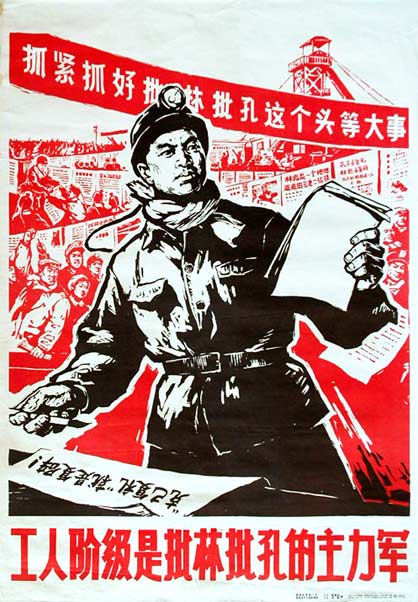
1974 – The working class is the main force in the campaign to denounce Lin Biao and Confucius

1975 – Kill the bastard Chen Zai-Dao as a sacrifice to the souls of our brave martyrs
You’ll recognize the style from the years of the Cultural revolution proper, it was a style that would not go out of fashion until the fall of the Gang of four. The first poster is part of the “Pi-Lin, Pi-Kong” campaign, or translated to english, “Criticize Lin [Biao], Criticize Confucius”. Confucian philosophy was identified as an obstacle to modernization during the Cultural Revolution, and the Pi-Lin, Pi-Kong campaign identified Lin Biao in particular as guilty of Confucianism. Keeping in mind that the campaign lasted from 1973-74, and that Lin Biao died in 1971, the campaign may seem a bit misdirected. However, it also had a more indirect traget, Zhou Enlai.
One of the few permanent fixtures in high level Chinese politics, Zhou had been the Premier of the People’s Republic since its establishment in 1949, managing throughout to avoid becoming a victim of Mao’s frequent fits of paranoia and purging. His high political standing, his pragmatic nature, and not least, his popularity with the people may have been the reasons why the Gang of four wanted to get rid of him, this campaign was a failed attempt at discrediting him with the people.
The second poster, featuring an incredibly butch sword-wielding woman, is directed at PLA general Chen Zaidao. His claim to infamy came in the city of Wuhan in 1967, in the midst of the Cultural Revolution, when he decided to arm the local population against a Red Guard faction trying to gain control of the city. After repeatedly ignoring orders from the central government in Beijing to lay down his arms, an overwhelming military force was dispatched to confront him, whereupon he surrendered and was stripped of his offices. However, he had been rehabilitated by 1972, and apparently, he was seen by some as an enemy of the vilest sort.
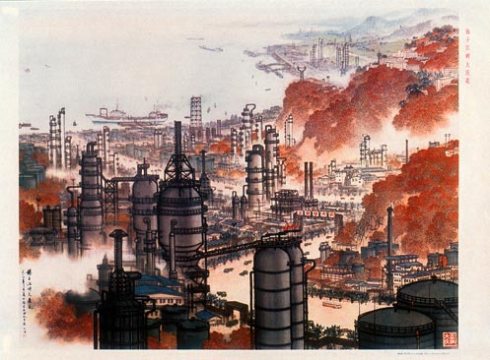
1975 – In industry, study Daqing
I’ve got a love of things which are ugly, ugly in a beautiful way. I can move through areas of old disintegrating factory halls, warehouses and other rusting crud, and while it’s decrepit and depressing, I also get a sort of tingle from it, there’s some sort of beauty in it all.
In that regard, this is an amazing painting, presenting the petroleum industry of model city Daqing in all its disgusting smoke and pollution, as a beautiful example, worthy of emulation. While I’m certainly not one to celebrate heavy industry and pollution as an unmitigated positive aspect of modern technology, I do love the graphical glorification of industry often found in communist propaganda.

1976 Man can conquer nature
In the west, environmentalism as an ideology has typically first been adopted by left wing political parties, socialist parties among them. Without looking at the actual historical situation, one could easily think that socialists and communist have always been more environmentally responsible than the capitalists and right wingers. Nothing is farther from the truth.
Communists are typically materialists, in the sense that they stress the improvement of living conditions for humans, which will usually happen at the expense of the natural environment. This slogan is as clear as any in that regard, humans can and should subdue and use nature to its own advantage.

1976 – Revolutionary committees are good
I don’t know too much about the background for this poster, but it doesn’t seem unlikely that it’s the work of the Gang of four, considering the graphic style used, the not-so-subtle inclusion of a Mao portrait, and a message promoting revolutionary committees, something which was also stressed during the Cultural Revolution proper.
Whatever the message, this is a fine poster in my eyes. With heavy use of red and green, coupled with strong contrasts, it’s not necessarily pretty, but it exudes a militant optimism that I can’t help being torn away by.

1976 – Toughen yourself by braving the wind and the waves
God I love this poster! Have you ever seen something so optimistic, so airy, so fresh? While the main character here seems to be using auto-levitation to cross the water (a young Jedi perhaps?), I read this poster as alluding to Mao’s promotion of swimming as a way for the Chinese people to improve their physical fitness.
Mao had advocated this from a young age, and used himself as an example in 1956 when he swam across the Chang Jiang (Yangtze) river. On the tenth anniversary of that swim, the whole thing was re-done, this time as a huge publicity event to demonstrate the Chairman’s undiminished strength.
1976 – Turn grief into strength, carry out Chairman Mao’s behests and carry the proletarian revolutionary cause through to the end
With the death of Mao on the 9th of September 1976, we come to the end of the second part of this series. With their great backer dead, the Gang of Four were soon arrested on the orders of Premier Hua Goafeng, the apparent successor in power to Mao.
On the matter of Mao’s memory, Deng Xiaoping would later make it official policy that Mao had been seven parts right and three parts wrong. That Mao has a controversial legacy is putting it mildly, in his 82 years you’ll find plenty of examples of both positives and negatives. For my part, the 30-40 million dead during the Great Leap Forward, the frequent, massive social upheavals initiated by him (most prominently the Cultural Revolution) and the general cruelty he was capable of stands out a lot more prominently than the good he may have caused.
March 31st, 2011 at 2:35 pm
China have excellent design, beautiful ideas and nice style in every posters and pictures what they have published since 1949, really enjoy to watch thatkind professional materials.
June 4th, 2011 at 3:48 am
[…] Image source: thinkingouttabox.wordpress.com […]
January 3rd, 2020 at 7:58 am
As for ‘Hold aloft the red lantern’, this is a clear allusion to an opera of this period: 红灯记
The exaggerated posture and facial expression are not supposed to be realistic as this is an opera pose.